7 Garage Overhead Storage Tips That Help You Use Your Space Wisely
Using your garage’s overhead space as a storage area is a great way to minimize garage clutter. The vertical space of a garage is commonly not used to its full potential.
Most garage floors have never been properly finished. That means their original concrete foundation works overtime dealing with the heavy demands homeowners place on them. All those years of wear from foot and vehicle traffic, snow and rain, dust, dirt, spills, and leaks eventually take a toll. It leaves garage floors with stains, cracks, other types of structural damage, and a less-than-attractive appearance. Unfinished garage floors in even relatively new homes leave a lot to be desired in the looks department, too. The best solution to repair, protect, and give garage floors a decorative upgrade is to have a good floor coating professionally applied. High-performance polyaspartic and polyurea floor coatings are both popular options and great epoxy floor coating alternatives. Polyaspartic and polyurea floor coatings offer many benefits Both coatings offer numerous benefits for concrete floors, such as protection, durability, aesthetic appeal, and fast cure times. If you’re doing a polyaspartic vs. polyurea floor coating comparison, it may not be very clear what the key differences between the coatings are, however. Our comprehensive polyaspartic vs. polyurea floor coating comparison guide will clarify things for you. We’ll be using Garage Living’s Floortex™ floor coating for our polyaspartic comparisons. Floortex™ was specifically created for Garage Living. We use it exclusively because it’s the best polyaspartic floor coating on the market. Making sense of polyaspartic and polyurea coating info online While doing research online to figure out whether a polyaspartic or polyurea floor coating is best for your garage, you’ve likely encountered plenty of confusing information. Simply making sense of the names of these coatings can be head-scratching. Coating product manufacturers and garage floor application companies sometimes use “polyurea” and “polyaspartic” interchangeably. Some companies call their coating “polyurea polyaspartic”, “polyurea/polyaspartic”, or “polyaspartic epoxy”. The spellings of the coatings can even be inconsistent. We’ve seen numerous examples where “poly-aspartic”, “poly-urea”, “poly aspartic”, and “poly urea” were used. Polyurethane is another type of floor coating, which only adds to the confusion. It doesn’t help that there is a lot of misleading and completely wrong information about polyaspartic and polyurea floor coatings online. This guide’s purpose is to present a Floortex™ polyaspartic vs. polyurea floor coating comparison that’s accurate and easy for anyone to understand. Polyaspartic vs. Polyurea Floor Coatings: Breaking Down the Basics We’ll briefly explain what polyaspartic and polyurea floor coatings are. You’re not reading this guide to get a science lesson, so we’ll keep the technical language to a minimum. Polyaspartic and polyurea are both resins that derive from polyurethane chemistry. Polyaspartic is a type of polyurea with a modified formulation that changes its properties for better performance as a floor coating. A coating that is classified as polyaspartic contains both polyaspartic and polyurea resins. Polyurea coatings are made with aromatic compounds, which makes them vulnerable to discoloration when they’re exposed to sunlight. The aliphatic compounds used to make Floortex™ and other types of polyaspartic coatings give it UV stability, which makes it superior to the UV resistance polyurea coatings offer. Better protection from damage caused by ultraviolet (UV) rays is one of the biggest differences between polyaspartic and polyurea floor coatings. These coatings typically have a two-component system. That means the polyurea or polyaspartic resin is combined with a catalyst (also known as a curing agent or hardener). Two or three coats are used for most polyurea and polyaspartic floor applications, which always includes a pigmented base coat and clear top coat. Both coatings are used to resurface the floors in commercial, industrial, and residential settings. Floortex™ polyaspartic and polyurea are higher-quality floor coatings compared to epoxy, as our polyaspartic vs. epoxy floor coating comparison blog post explains. Can you use polyaspartic and polyurea coatings together? A lot of garage floor companies do their applications with a polyurea base coat and a polyaspartic top coat. That’s likely why some of their flooring systems use the term “polyurea polyaspartic”. While they technically aren’t wrong, such marketing language can make things more confusing. The process of pairing polyurea and polyaspartic coatings is one area where there’s a considerable amount of misleading and incorrect information online. One claim some companies make is that you get the best results when the coatings are applied with this method, which isn’t true. Another claim is that a polyurea base coat won’t discolor because a polyaspartic top coat protects it. This is also wrong because pure polyurea isn’t UV-stable. Even if it’s used as a pigmented base coat, a polyurea coating is guaranteed to turn yellow or green rapidly if exposed to sunlight or any UV light source . Even on a floor that is 100% covered with decorative flakes, 5-10% of the base coat is always visible. A Floortex™ base coat and top coat are both high-quality polyaspartic, which delivers superior performance results. Floortex™ polyaspartic vs. polyurea floor coatings: 5 key differences If you’re trying to decide which of these two types of floor coatings to buy, it’s essential to know about the key differences between Floortex™ polyaspartic and polyurea coatings. Let’s start our Floortex™ polyaspartic vs. polyurea floor coating comparison by looking at their main differences. 1. UV damage protection Approximately 10% of sunlight contains UV rays and about a third of those rays pass through the atmosphere and reach the ground. That may not sound like much, but it is the power of the sun we’re talking about, which is why we use things like sunscreen and eyeglasses with UV protection. Those powerful UV rays cause the chemicals in polyurea and epoxy floor coatings to break down quicker over time. UV rays make contact with a garage floor in several different ways: the average garage door opens and closes about 1,500 times per year many garages have wall windows and windows in an exterior access door some garage doors have clear or translucent windows indoor lights emit small amounts of UV light Eventually, coatings that aren’t UV-stable will lose their glossy finish and they’ll discolor and yellow. Some polyurea coatings have UV inhibitors or stabilizing additives to make them less sensitive to UV exposure. While these measures make a coating more UV-resistant, they’re still only slightly delaying the degradation process. Floortex™ polyaspartic floor coating’s top-notch UV protection properties are one of the biggest differences it has with polyurea coatings. Floortex™ holds its color and shiny finish much longer than any polyurea or epoxy coating and will never yellow. 2. Surface protection and durability There’s a very good reason polyaspartic and polyurea floor coatings are commonly used in areas that get heavy foot and vehicle traffic. Places like retail spaces, warehouses, restaurants, manufacturing plants, aircraft hangers, and home garages use these coatings for their strength and resilience. The chemical makeup of both coatings makes them significantly more durable than epoxy. High-quality polyaspartic and polyurea-coated floors that are properly maintained typically last anywhere from 10-20 years and even longer in some cases. That’s much longer than any epoxy floor coating will last. In terms of protection and durability, both coatings also offer excellent performance in the following areas: delamination resistance (which prevents a floor’s top surface from separating from the underlying substrate) resistance to pitting (where small holes form on a floor surface) hot tire pickup resistance (when warm and hot tires leave dark smudges on a floor) prevents concrete degradation As durable as many types of polyurea coatings are, they fall short when compared to the durability and protective performance of Floortex™ in the following key areas: abrasion and impact resistance (it’s less vulnerable to scratching, chipping, and scuffing) higher resistance to most household and automotive chemicals Floortex™ coating offers a higher level of overall physical durability better aesthetic durability and color stability that prevents the surface coat from yellowing Consider that the superior physical and aesthetic durability of a Floortex™ coating is a smarter long-term investment. A higher-quality floor coating will last for longer before it needs to be replaced or repaired. 3. Workability and curing time We previously mentioned that polyaspartic is a modified type of polyurea that offers some improved features. A major difference is the amount of time it takes each type of coating to cure (curing basically means how long it takes an applied liquid material to dry or harden). Polyaspartic coatings have a slowed-down cure rate compared to polyurea coatings. According to Corrosionpedia, polyurea coatings typically cure in two to five minutes, while polyaspartic coatings have a cure time ranging from 10 to 45 minutes. Weather and environmental conditions can cause curing times to vary. This makes polyaspartic floor coatings easier to work with than polyurea coatings. Here’s what we mean: workers applying polyaspartic coatings have less of a time constraint, which decreases the likelihood of installation errors polyaspartic’s more forgiving cure times lets workers correct any errors or issues before a coating dries a wider time frame makes it easier to ensure a polyaspartic coating is evenly applied and thoroughly covers an entire floor surface The fast curing times of both polyaspartic and polyurea floor coatings are convenient if multiple coatings are being applied. Their rapid drying times also allows floor resurfacing projects to be completed in a shorter amount of time. 4. Bonding performance An important consideration for a floor coating is how well it bonds with concrete. One benefit of having a stronger surface bond is that it makes a coating more durable and protective. Polyaspartics provide a better mechanical bond to concrete than polyurea, epoxy, urethane, or acrylic coatings. Floortex™ polyaspartic coating deeply penetrates concrete surfaces, providing the highest level of adhesive bond. A big reason for the difference in bonding performance is that polyurea’s faster curing time leaves less time for the material to soak in and adhere to the concrete. Most polyurea coatings only have a moderate level of concrete penetration. We add a solvent that helps Floortex™ cure slower, allowing it properly penetrate the concrete and create an ultra-strong bond. Another reason polyurea and polyaspartic coatings bond better than epoxies is because they provide better surface coverage. Epoxy has a molasses-like thickness, whereas polyurea and polyaspartics have a more water-like consistency. Both coatings penetrate the concrete more effectively by getting into its pores, cracks, and crevices. 5. Cost As you do your polyaspartic vs. polyurea comparison homework, a big factor that will influence your buying decision is the project cost. Polyaspartic floor coatings are usually pricier than polyurea coatings. That’s because the advanced formulation of polyaspartic uses more expensive materials during the manufacturing process. Although polyaspartic is a costlier option than polyurea, the long-term benefits from its superior performance tend to outweigh the higher initial cost. Once again, remember that a higher-quality floor coating’s durability provides better long-term value. Factors like a garage’s square footage, your design choices, the concrete’s condition, and whether or not any extra repair work is required all affect the cost of a floor project. The materials used, the floor preparation process, and how a coating is applied are other important factors you need to be well-informed about. Floortex™ and other high-quality polyaspartics have a higher solids content percentage of around 85-100%. That means there’s more solids content that stays on the floor and less water that will evaporate. Some garage floor applicators will cut costs by using polyurea or, even worse, epoxy base coats. You should avoid these companies — their prices are too good to be true for a very good reason! Other companies will cut corners by applying less material for their coatings. This leaves a thinner, less protective “dry film thickness”, which is the thickness of the floor after curing. Garage Living’s floors are thicker than most once cured. How can Garage Living install a premium Floortex™ system for such a competitive price? One reason is that unlike some companies, we don’t use a primer coat before applying the base coat, flakes (if desired), and then the top coat. The strong bonding properties, high quality, and versatility of Floortex™ coating makes the use of a primer coat unnecessary. That cuts down on a customer’s material and labor costs. Another reason polyaspartic and polyurea coatings cost more than epoxy coatings is that specialized equipment and a high level of expertise are needed to apply them. Floortex™ polyaspartic vs. polyurea floor coatings: 11 similarities Now let’s look at 11 things that Floortex™ and polyurea floor coatings have in common. 1. High aesthetic appeal It’s no wonder that most garages look drab. Their floor has an unfinished concrete surface with perhaps the most boring shade in the color palette: gray. Polyurea and polyaspartic floor coatings offer a sleek, high-gloss finish that enhances the aesthetic appeal of any space. These coatings create a modern, polished look that complements both residential and commercial settings and their durability helps them retain their appearance even in high-traffic areas. Many coating applications add decorative flakes in random shapes and sizes, which helps enhance a floor’s appearance with varying colors and refined textures inspired by natural stone. The texture of the flakes gives floors slightly better traction and they also help hide dirt and dust. All of these decorative features add an alluring style to a garage floor and make the room feel more inviting. And because most garages don’t have a decorative floor coating, any home that does have one instantly stands out! 2. Lots of design versatility Polyaspartic and polyurea coatings are typically available in a variety of colors and finishes. They can be customized to match any design aesthetic, from simple solid colors to a bolder look with patterns. Some companies can even incorporate logos and other complex designs when they’re applying a coating. This is yet another area where the coatings are superior to epoxies and another reason they’re such an ideal choice for showrooms, retail spaces, and other areas (like a home garage) where aesthetics are important. If a garage floor resurfacing company you’re considering using has a limited amount of color and customization options available, keep shopping around. Reputable garage remodel companies like Garage Living know their clients appreciate having as much design versatility as possible. We currently offer many different floor coating colors, along with a variety of luxurious colors with finer flake textures for added depth and sophistication. The flakes can be custom-blended to create one-of-a-kind floor color combinations. Our design experts are constantly innovating, too, so you never know what new colors and products we may add in the future! 3. Quick project turnaround time One of the bigger selling points for both types of coating is that their rapid curing times allow for a much quicker project turnaround time compared to epoxies. Floortex™ and polyurea coating applications can be completed in as little as one day. In most cases, you can walk on a garage floor the same day that the coating has been applied (after about 12 hours). This fast turnaround time gets your garage back in service quicker. The efficiency with which these coatings can be applied is another reason they’re used so often for projects with tight deadlines and where downtime needs to be minimized, such as in hospitals, schools, and retail settings. Because polyurea dries faster, vehicle traffic on a coated floor can resume sooner (after about 24 hours compared to 48-72 hours for polyaspartic coatings). Garages with epoxy-coated floors are commonly unusable for approximately four days to a full week. Note that these time estimates are dependent on several factors, including: environmental conditions product quality mix ratios coating thickness the expertise of workers preparing the floor and applying the coating 4. Floor preparation process For any concrete floor getting resurfaced, proper preparation is a critical part of the installation process. Regardless of whether a polyaspartic, polyurea, or epoxy coating is being used, you’ll get better results on a floor where thorough and correct prep work has been done. The floor preparation methods for polyurea and polyaspartic coatings are very similar. As the first step in Garage Living’s 5-step floor coating application process, our crews evaluate a floor’s concrete density so they can select the right type of diamond blades to use on it. Garage Living uses state-of-the-art diamond grinders and dustless self-contained vacuum systems to ensure the best results. Diamond grinding machines use diamond-tipped blades that level and clean concrete surfaces as they rotate, as well as opening up the concrete’s pores. Once the entire floor surface has been diamond grinded, a hand grinder is used for the floor edges. Repairs of cracks, chips, pitting, and other surface imperfections come next. We use a diamond cutting wheel to open any cracks and then fill them with a polyurea filler or cementitious mortar. Once the repair material has cured (in about 25 minutes), any excess material is ground off. Now that the floor is completely smooth, any remaining dust and debris is vacuumed. 5. Application process The application process for polyaspartic and polyurea is relatively similar, although some companies have different methods they use. A base coat typically involves mixing two or more components. Garage Living uses a 2-component polyaspartic system and we add pigment to the base coat that matches our customer’s choice of pre-blended vinyl flakes. Floor coatings are typically brushed or rolled on to ensure even coverage. Polyurea coatings can also be sprayed on, which sometimes occurs in commercial settings. If the customer wants their floor to have decorative flakes, they’re broadcast over the entire surface. Garage Living lets the floor cure for about 60 minutes and then removes all excess flake material with a flat metal-edge tool to leave an even and smooth base coat. A top coat application is the final step for a floor resurfacing project. We apply a clear Floortex™ top coat with a squeegee and then backroll it to leave a thick, even layer with a consistent high-gloss finish. As we’ve covered, using polyaspartic coatings presents fewer challenges to installers compared to polyureas. One more example of this is that polyurea coatings are far more sensitive to temperature and humidity than polyaspartics. If decorative flakes have been spread on a polyurea base coat, it’s harder to know exactly when it’s okay to scrape off the excess material. Polyurea coatings also tend to use more unconventional mix ratios, which makes installers more prone to errors. 6. They’re not DIY-friendly While researching the topic of polyaspartic vs. polyurea coatings online, a surprising number of sites claim that the application process for both coatings is “simple” or “quick and easy”. This simply isn’t true. Neither coating is DIY-friendly because applications require a high level of expertise to use and expensive, specialized equipment must be used. The coating materials also cost more than the epoxy coatings you can buy online or in a home improvement store. With the much narrower margin for error that polyurea and polyaspartic coating applications allow, it’s a big risk for an untrained person to try and do it by themselves. For starters, a DIYer probably wouldn’t know that a minimum of two people is needed to do the project. Here are some common problems that can occur when an untrained person tries to install a floor with these two types of coatings: having a shortage of materials to cover the entire floor poor coating adhesion to the concrete surface imperfections including air bubbles, peeling, and uneven colors A floor installed by reputable professionals like Garage Living will have a professional, superior look, without any cosmetic or structural issues. A proper installation ensures your garage floor maintains its high-end appearance and won’t need to be repaired or replaced for many years to come. 7. Year-round applications A major advantage these two coatings have over epoxies is that they can be applied in a much broader range of temperatures. To apply an epoxy coating, a minimum temperature of 50-55° F (10-13° C) is required. Polyaspartic and polyurea coatings, however, can be applied even in extreme temperatures ranging from -40° F to 40° F (-40° C to 4° C). Garage Living can do flooring projects virtually any time of the year anywhere in the U.S. or Canada. Floortex™ is one of the only coating products that can be formulated in three different speeds (slow, medium, and fast) to allow for installation in almost any temperature. The colder it is, the faster speed you need to use. It’s a lot more convenient when you can schedule a garage floor installation year-round instead of being dependent on the weather. There are several reasons why it’s actually a good idea to get your garage floor coating done in the winter. Having a durable garage floor with protective features is especially practical if you live in a northern climate. Winters in snowy areas take a big toll on garage floors with all the snow, ice, salt, sand, and de-icing products that get brought inside by your vehicles and footwear. 8. Superb flexibility Polyaspartic and polyurea-coated floors have excellent elastic properties. You might not think that matters with something as solid as concrete, but there are two key reasons why it’s so important. First, temperature variations cause a garage floor to expand and contract. The flexibility these coatings provide can stand up to the stress that temperature changes put on concrete. This stress can cause numerous structural issues on a floor, such as cracks, peeling, and delamination. Second, this elasticity also protects floors from being damaged over time from having heavy vehicles parked on them, general heavy use, and when a weightier item like a large power tool is dropped on the concrete. The coatings’ flexibility allows them to effectively absorb impacts and redistribute that force to prevent surface damage. 9. They’re low maintenance Floors with these coatings require minimal maintenance. Their seamless, non-porous surface resists stains, dirt, and moisture, reducing the need for frequent deep cleaning. Unlike some flooring options that may require waxing or refinishing, polyaspartic and polyurea coatings retain their durability and shine with simple routine care. A quick sweep and an occasional more thorough light cleaning with a squeegee, some water, and a gentle cleanser is usually enough to keep them looking pristine. Sweeping or using a squeegee on a smooth floor without cracks or small chunks of concrete missing is easier. Cleaning up spills is also a breeze, too, and most household chemicals won’t leave a lasting stain like they would on bare concrete. One reason garages get so dusty is that their bare concrete floors wear down over time, creating very fine dust that gets airborne from foot and vehicle traffic. Polyaspartic and polyurea-coated floors prevent the concrete from wearing down and adding to the garage’s level of dust. Because Floortex™ floors don’t harbor dust or allergens, they contribute to a healthier indoor environment. And once again, Floortex’s decorative flakes help obscure dirt and debris, so your floor will look cleaner even when it needs a little cleaning attention! 10. Excellent sealing ability Both floor coatings are known for their excellent sealing properties, providing a protective barrier that enhances a floor’s durability. Floortex™ coatings create a 100% seamless and non-porous water-resistant seal over the garage floor that preserves the concrete’s structural integrity. This seal helps reduce moisture vapor transmission, which is a common problem in garages. Moisture vapor can escape through pores in the concrete, causing damage to a floor over time and also increasing humidity levels in a garage. Garage Living also offers Floortex™ Moisture Blocking Primer, which is ideal for floors that have higher moisture levels. Having a waterproof garage floor is quite beneficial because of the toll water from rain and melted snow takes on concrete. When moisture gets down into a floor’s cracks and refreezes when the temperature drops, the natural expansion and contraction process undergoes even more stress. 11. Vertical application ability Polyaspartic and polyurea coatings aren’t limited to just being used on a garage floor. The coatings can also be applied on vertical surfaces like walls (for a baseboard-style look) and steps because they adhere so well, unlike epoxy coatings. A coating that is applied on a vertical surface matches the coating used on the floor. Here are a few ways a garage can benefit from the coatings’ vertical application functionality: it adds an extra decorative touch that completes the room’s look gaps between the walls and floor are covered up for a seamless wall-to-floor transition drafts are eliminated, improving energy efficiency it helps keep pests out drywall is better protected from water damage Get the best garage floor coating available As you can see from our polyaspartic vs. polyurea comparison, both floor coatings share many great features. Garage Living’s Floortex™ coating is superior to polyurea coatings in two of the most important areas for anyone who buys a floor coating—durability and protection. Creating beautiful garages is what Garage Living does. An attractive floor that provides high-performance protection is a big part of our garage transformation process and it’s Floortex™ we rely on.

Using your garage’s overhead space as a storage area is a great way to minimize garage clutter. The vertical space of a garage is commonly not used to its full potential.
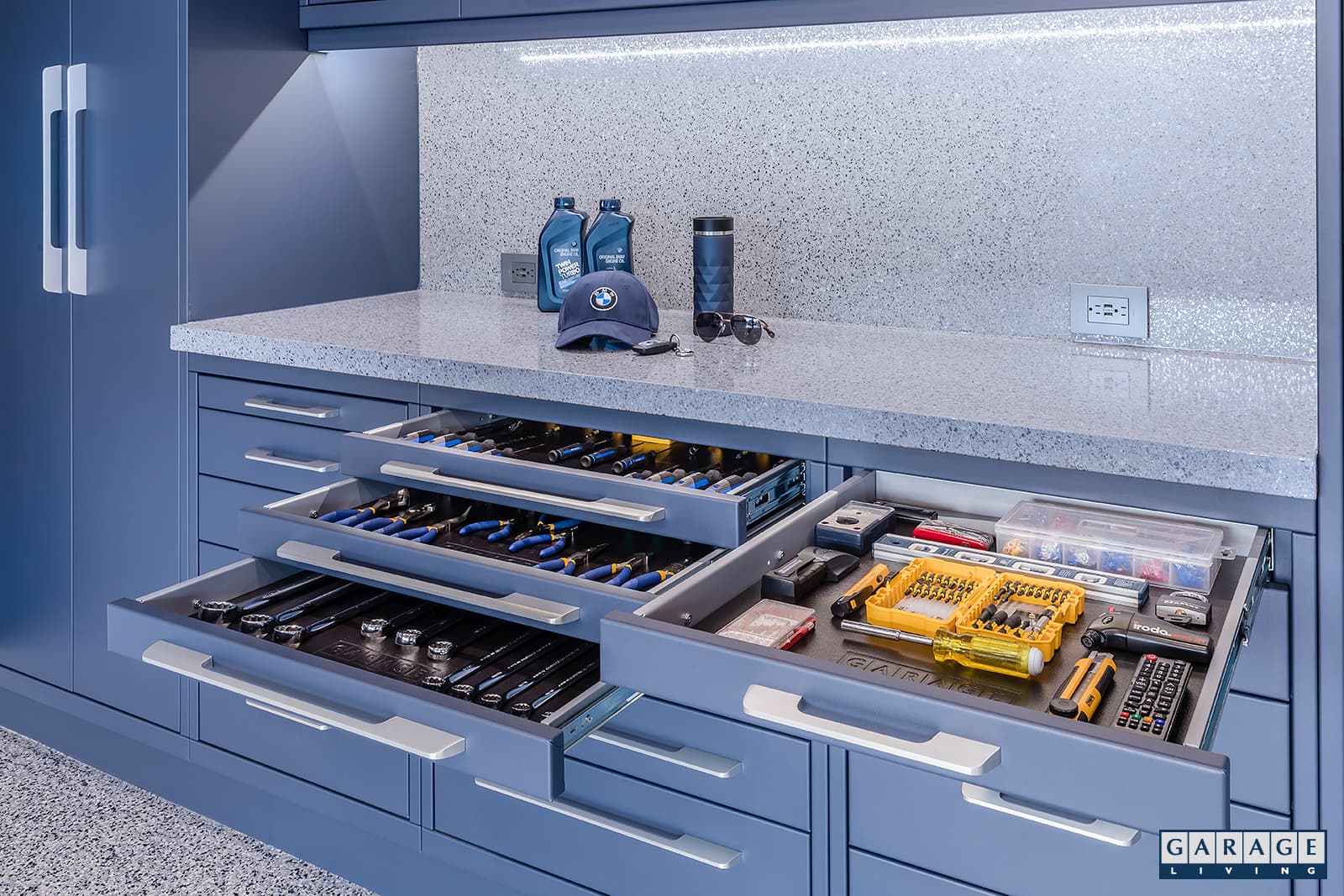
Certain Father’s Day gift ideas can convey a rather “going through the motions” approach to gift-giving on what’s supposed to be dad’s special day.
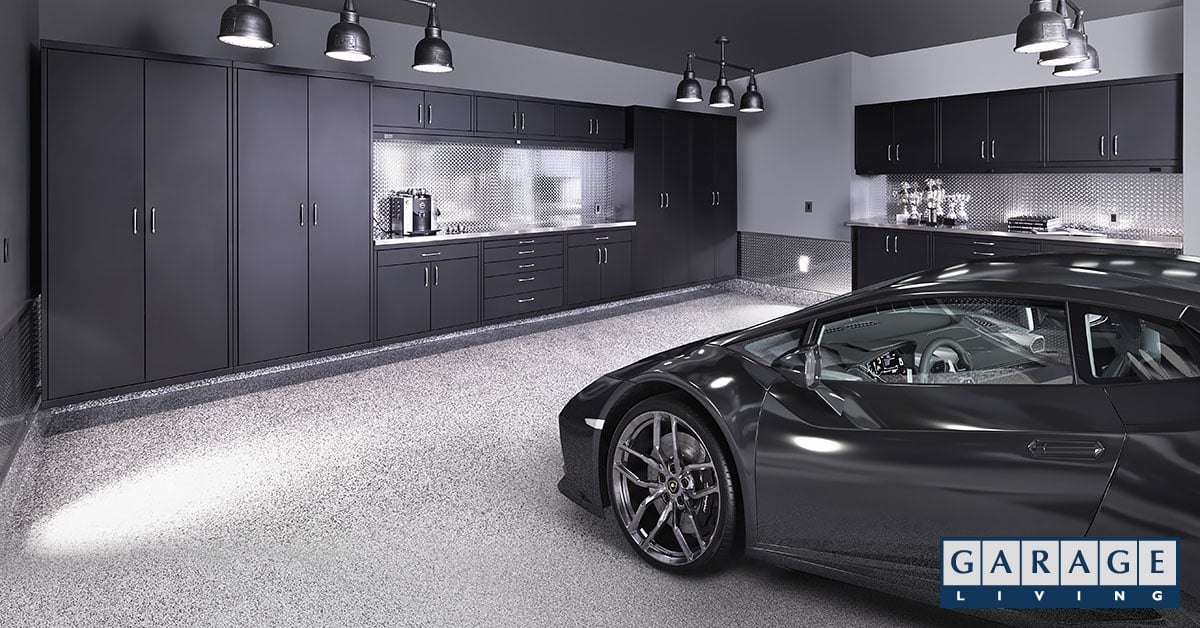
A well-designed garage makeover project focuses on making the garage beautiful and functional. Your garage space should be an extension of your home’s architecture, design, décor, and lifestyle.
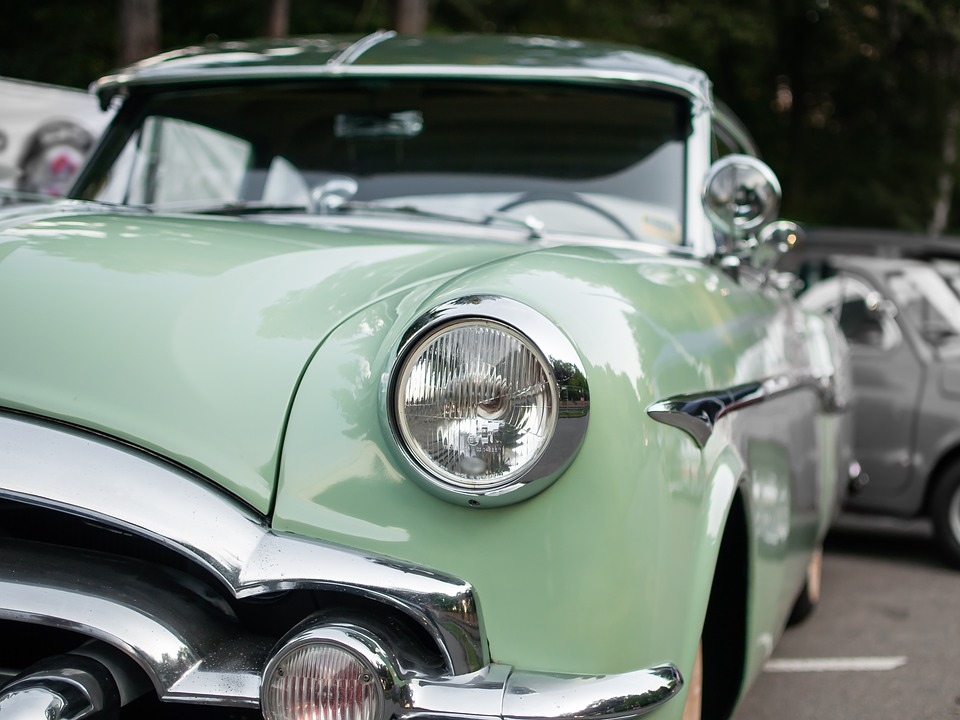

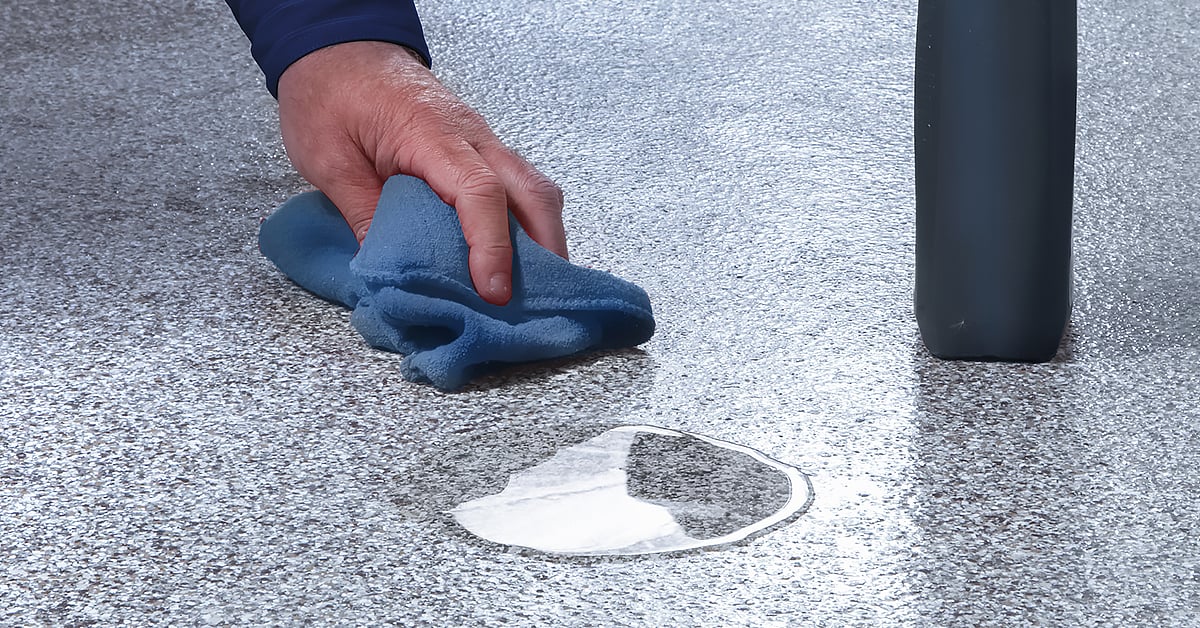
When it comes to potentially hazardous areas in houses, garages are one of the most overlooked and ignored spots by homeowners. So why are garage safety hazards not given the attention they’re due? It may be because many homeowners consider the garage more of a “separate” area of the home that doesn’t require the same level of organization and cleanliness found in the traditional interior of the house.

Summers traditionally provide auto enthusiasts plenty of opportunities to indulge in their passion and appreciation for classic cars and trucks.
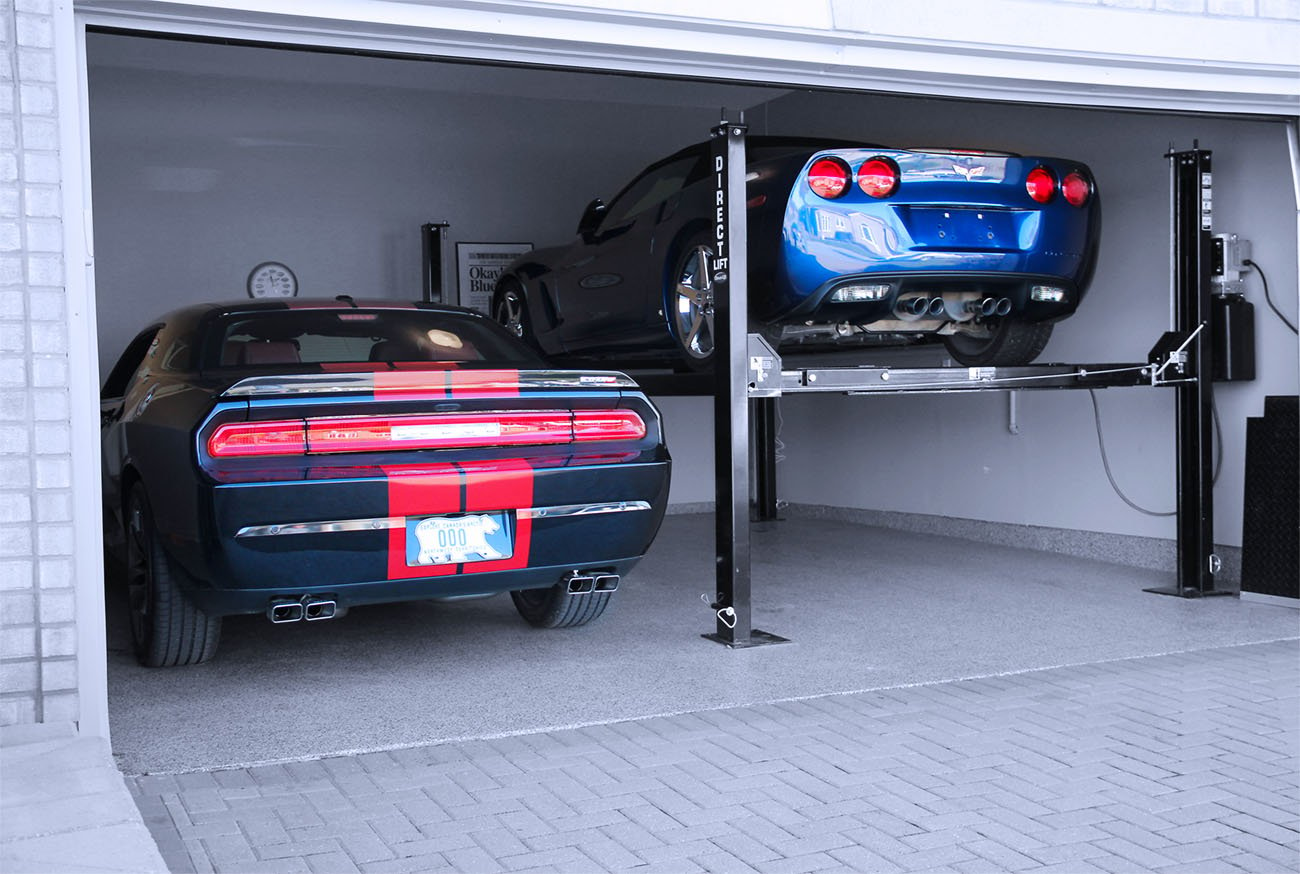
Simple logic dictates that a one-car garage will allow you to park a single vehicle inside of it and a two-car garage will make space for two vehicles, right? Not exactly.
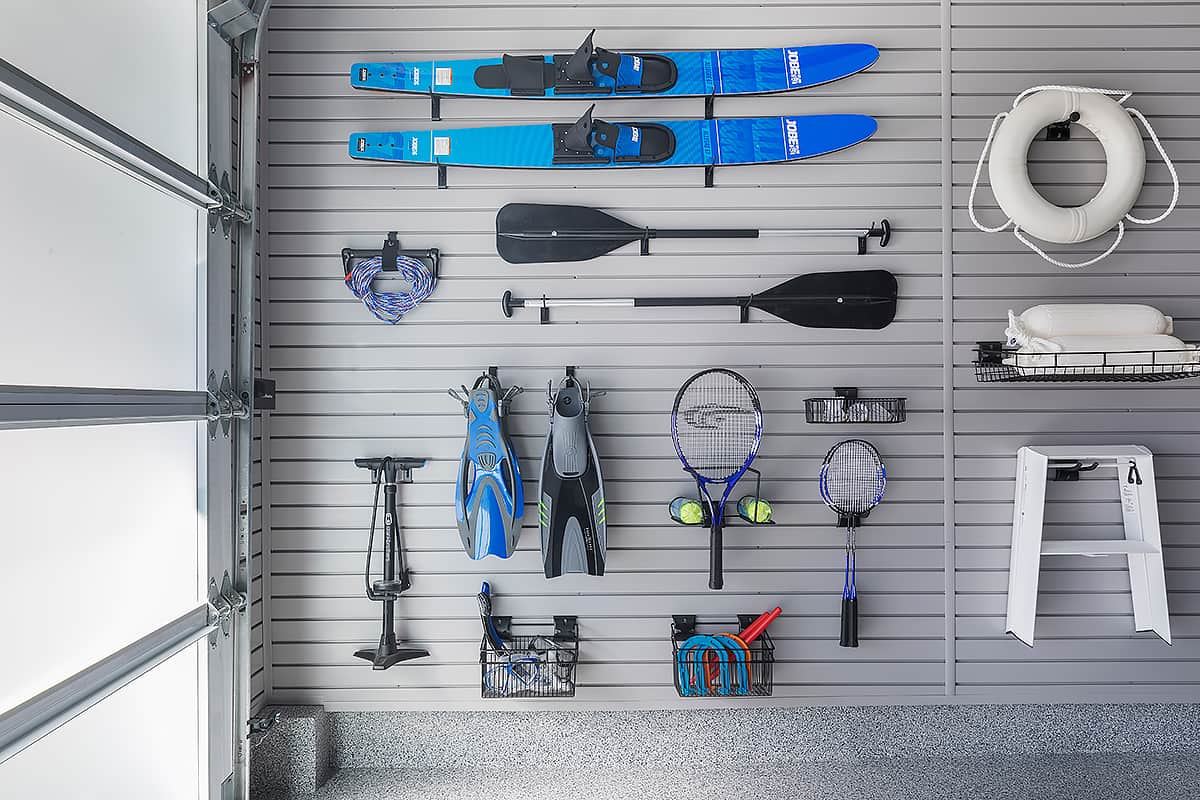
Despite garages being one of the most used spaces in homes, they are also commonly the most cluttered. A study conducted by the National Association of Professional Organizers found that 50% of homeowners named the garage as their home’s most disorganized area. 74% of homeowners surveyed by the Wall Street Journal said parking was the most important function of their garage. Even though so many homeowners agree on a garage’s main purpose, however, a SpareFoot survey shows that more than half of Americans are unable to park in their garage.
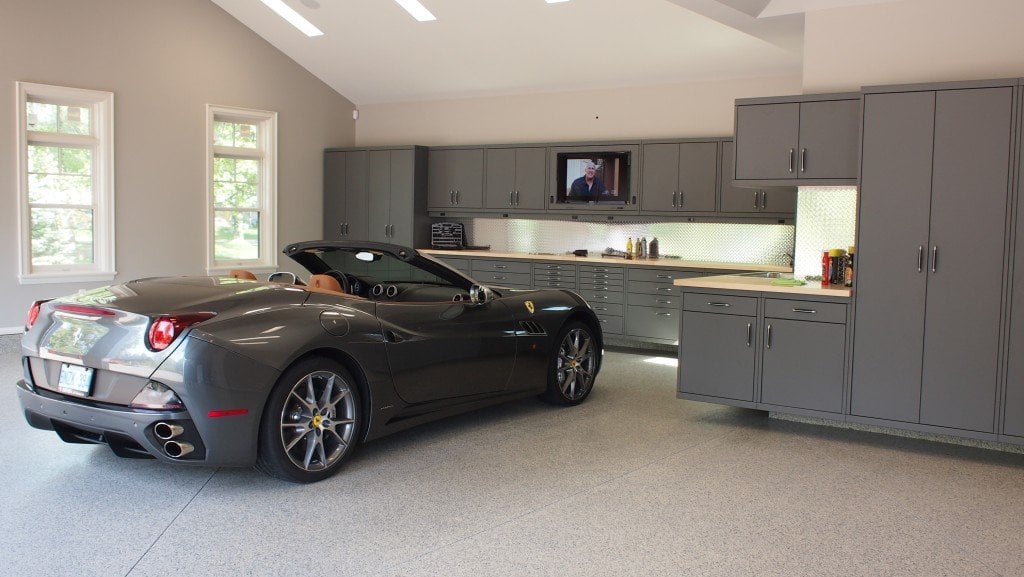
Your home resale value will be determined by many different factors. Some factors, like the age of your home, its location, and the selling prices of nearby homes will be out of your control.